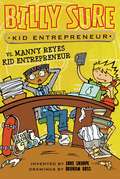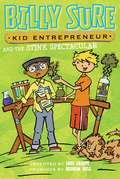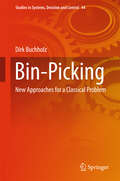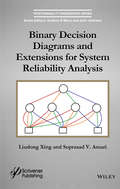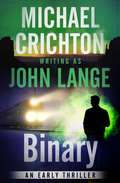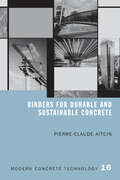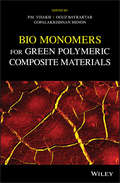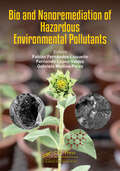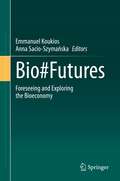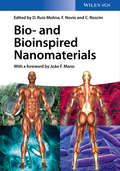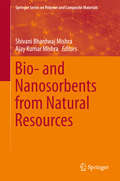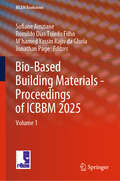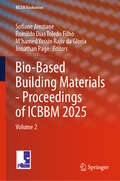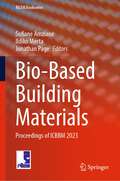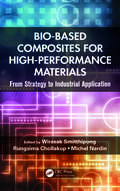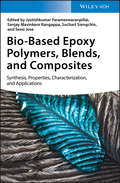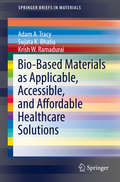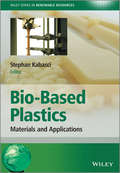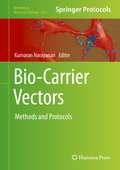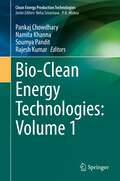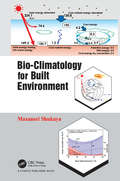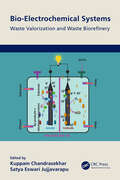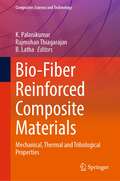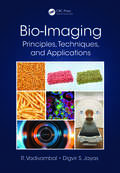- Table View
- List View
Billy Sure Kid Entrepreneur vs. Manny Reyes Kid Entrepreneur
by Graham Ross Luke SharpeBilly Sure and Manny Reyes switch jobs at Sure Things, Inc. in the eleventh book of a hilarious middle grade series!Meet Manny Reyes, inventor and CEO of Sure Things, Inc….wait, what?! It’s a friendly switcheroo at Sure Things, Inc.! Manny decides to roll out Sure Things, Inc.’s Next Big Thing—the Candy Toothbrush. Of course every good inventor needs a good CFO, so Billy steps up to the plate. But is Manny a better kid inventor than Billy? And does Sure Things, Inc. have room for the both of them? Find out in this wacky story with funny black-and-white illustrations throughout.
Billy Sure, Kid Entrepreneur and the Stink Spectacular: Billy Sure Kid Entrepreneur; Billy Sure Kid Entrepreneur And The Stink Spectacular; Billy Sure Kid Entrepreneur And The Cat-dog Translator; Billy Sure Kid Entrepreneur And The Best Test (Billy Sure Kid Entrepreneur #2)
by Graham Ross Luke SharpeBilly Sure, twelve-year-old inventor and CEO of Sure Things, Inc., adds espionage to his resume in the second book of a hilarious middle grade series!Billy Sure is many things: CEO of Sure Things, Inc., a sleepwalking seventh-grader, and now he's adding spy to the list! When Billy finds out he's been exchanging emails with a corporate spy from a rival company, he's not happy. So he enlists the help of his mother and his best friend and CFO, Manny, to set a trap to catch the shady email impostor before he can reveal Sure Things, Inc.'s valuable secrets! Meanwhile, Billy and Manny are arguing about Billy's newest invention--the Stink Spectacular. Billy thinks the Stink Spectacular is the next All Ball, but Manny's not convinced. Can Billy save his company from sabotage, come up with his next big invention, and survive his dad's terrible cooking?
Billy Sure, Kid Entrepreneur: Billy Sure Kid Entrepreneur; Billy Sure Kid Entrepreneur And The Stink Spectacular; Billy Sure Kid Entrepreneur And The Cat-dog Translator; Billy Sure Kid Entrepreneur And The Best Test (Billy Sure Kid Entrepreneur #1)
by Graham Ross Luke SharpeMeet Billy Sure, twelve-year-old inventor and CEO of Sure Things, Inc., and discover all of his wild and wacky inventions in this start to a hilarious middle grade series!Everyone is talking about Billy Sure, the twelve-year-old CEO of Sure Things, Inc. and genius inventor of the All Ball, a ball that turns into different sports balls with the push of a button. Now Billy wants to help other kids achieve their inventing dreams just like he has!So Billy is hosting an online contest for other kid-inventors to share their inventions, and the winning submission will be produced by his company. Ideas like the Sibling Silencer, No-Wash Socks, and a pencil that does all your work start pouring in. With so many great ideas, how is Billy supposed to pick a winner?And that's not all. Billy also has to keep the secret that could take him from hero to zero in a flash if anyone found out. Can Billy Sure find a way to stay on top of the world and help other kids achieve their dreams at the same time? Each book in this series includes Billy's drawings and doodles of inventions and more!
Bin-Picking: New Approaches for a Classical Problem (Studies in Systems, Decision and Control #44)
by Dirk BuchholzThis bookis devoted to one of the most famous examples of automation handling tasks -the "bin-picking" problem. To pick up objects, scrambled in a box is aneasy task for humans, but its automation is very complex. In this book threedifferent approaches to solve the bin-picking problem are described, showinghow modern sensors can be used for efficient bin-picking as well as how classicsensor concepts can be applied for novel bin-picking techniques. 3D pointclouds are firstly used as basis, employing the known Random Sample Matchingalgorithm paired with a very efficient depth map based collision avoidancemechanism resulting in a very robust bin-picking approach. Reducing thecomplexity of the sensor data, all computations are then done on depth maps. This allows the use of 2D image analysis techniques to fulfill the tasks andresults in real time data analysis. Combined with force/torque and accelerationsensors, a near time optimal bin-picking system emerges. Lastly, surface normalmaps are employed as a basis for pose estimation. In contrast to knownapproaches, the normal maps are not used for 3D data computation but directlyfor the object localization problem, enabling the application of a new class ofsensors for bin-picking.
Binary Decision Diagrams and Extensions for System Reliability Analysis
by Suprasad V. Amari Liudong XingRecent advances in science and technology have made modern computing and engineering systems more powerful and sophisticated than ever. The increasing complexity and scale imply that system reliability problems not only continue to be a challenge but also require more efficient models and solutions. This is the first book systematically covering the state-of-the-art binary decision diagrams and their extended models, which can provide efficient and exact solutions to reliability analysis of large and complex systems. The book provides both basic concepts and detailed algorithms for modelling and evaluating reliability of a wide range of complex systems, such as multi-state systems, phased-mission systems, fault-tolerant systems with imperfect fault coverage, systems with common-cause failures, systems with disjoint failures, and systems with functional dependent failures. These types of systems abound in safety-critical or mission-critical applications such as aerospace, circuits, power systems, medical systems, telecommunication systems, transmission systems, traffic light systems, data storage systems, and etc. The book provides both small-scale illustrative examples and large-scale benchmark examples to demonstrate broad applications and advantages of different decision diagrams based methods for complex system reliability analysis. Other measures including component importance and failure frequency are also covered. A rich set of references is cited in the book, providing helpful resources for readers to pursue further research and study of the topics. The target audience of the book is reliability and safety engineers or researchers. The book can serve as a textbook on system reliability analysis. It can also serve as a tutorial and reference book on decision diagrams, multi-state systems, phased-mission systems, and imperfect fault coverage models.
Binary: A Novel (Fiction Omnibus Ser.)
by Michael Crichton John LangeWhen a nerve gas shipment goes missing, the nation's fate hangs in the balanceJohn Graves is a State Department intelligence agent who made his name on the front lines of the Cold War. Since then, he's been transferred to domestic work, and his love for the job has withered away. All that sustains him is the hunt for John Wright--a crazed millionaire who is about to unleash the greatest domestic threat Graves's agency has ever faced.When seven mobsters rob a U.S. Army train in the middle of the Utah desert and make off with half a ton of the deadliest nerve gas known to man, Graves believes that Wright is involved. His plan: to detonate the weapon in San Diego during the Republican National Convention--an attack that would kill more than one million Americans, including the president. Stopping Wright will take more than police work. It is a chess match between agent and madman, and for Graves, checkmate is not an option. This ebook features an illustrated biography of Michael Crichton including rare images from the author's estate.
Binders for Durable and Sustainable Concrete (Modern Concrete Technology)
by Pierre-Claude AitcinLinking theory to practice, this book provides a better fundamental understanding of Portland cement and hydraulic binders which is necessary to make better concrete. It has been clearly demonstrated that concrete durability is closely linked to its water/binder ratio and proper curing during the first week after casting. In this rigorously present
Bio Monomers for Green Polymeric Composite Materials
by Oguz Bayraktar Visakh P. M.Presents new and innovative bio-based monomers to replace traditional petrochemical-based building blocks Featuring contributions from top experts in the field, this book discusses new developments in the area of bio monomers and green polymeric composite materials. It covers bio monomers, green polymeric composites, composites from renewable resources, bio-sourced polymers, green composites, biodegradation, processing methods, green polymeric gels, and green polymeric membranes. Each chapter in Bio Monomers for Green Polymeric Composites Materials presents the most recent research and technological ideas in a comprehensive style. It examines bio monomers for green polymer and the processing methods for the bio nanocomposites. It covers the preparation, characterization, and applications of bio-polymeric materials based blends, as well as the applications of biopolymeric gels in medical biotechnology. The book also explores the properties and applications of gelatins, pectins, and carrageenans gels. Additionally, it offers a plethora of information on green polymeric membranes; the bio-degradation of green polymeric composites materials; applications of green polymeric composites materials; hydrogels used for biomedical applications; and the use of natural aerogels as thermal insulations. Introduces readers to the innovative, new bio-based monomers that are taking the place of traditional petrochemical-based building blocks Covers green polymers, green composites, bio-sourced polymers, bio nanocomposites, biodegradable polymers, green polymer gels, and membranes Features input from leading researchers immersed in the area of study Bio Monomers for Green Polymeric Composites Materials is suitable for academics, researchers, scientists, engineers and advanced students in the field of bio monomers and green polymeric composites materials.
Bio and Nanoremediation of Hazardous Environmental Pollutants
by Fernando Fabián GabrielaThis book is a compendium of knowledge about nanomaterials and strategies for bioremediation over hazardous environmental pollutants. The book is divided into 2 sections. Section 1 deals with the polluted environment, where it explains that soil is in serious danger and highlights the primary hazardous pollutants. Besides, this section covers algae, autochthonous, introduced, or genetically modified organisms that are used to degrade hazardous contaminants. In Section 2, Bio- and Nanoremediation are shown through synthesis, green synthesis and molecular farming, and their applications or impacts. Moreover, this discusses bio- and nano-remediation, working together for better performance, organisms, and nanomaterials for environmental remediation.
Bio#Futures: Foreseeing and Exploring the Bioeconomy
by Emmanuel Koukios Anna Sacio-SzymańskaThis volume presents a timely recognition, warning and mapping of the fast approaching wave, or “bio-tsunami”, of global socio-technical transformation, built by a much wider spectrum of converging powers, including biotechnology, new agriculture, novel foods, health, quality of life, environment, energy, sustainability, education, knowledge management, and design of smart applications. The book contains eight sections corresponding to different clusters of bioeconomic and socio-technical change, as identified by the editors’ “Scanning the Horizon” foresight research; it also offers an integrated view of the future bioeconomy landscape though the convergence of several technologies that affect everyday life. The clusters offer methodologies for forecasting the future bioeconomy, and how these predictions can affect target-setting and the orientation of policies and actions to manage cultural and societal change, and achieve sustainable development in less developed areas. The book will be of interest to researchers, producers, logistics experts, policy makers, regulators, business and financial institutions, and biotechnologists (e.g. geneticists, food experts, etc.).
Bio- and Bioinspired Nanomaterials
by Claudio Roscini Daniel Ruiz-Molina Fernando NovioA comprehensive overview of nanomaterials that are inspired by or targeted at biology, including some of the latest breakthrough research. Throughout, valuable contributions from top-level scientists illustrate how bionanomaterials could lead to novel devices or structures with unique properties. The first and second part cover the most relevant synthetic and bioinspired nanomaterials, including surfaces with extreme wettability properties, functional materials with improved adhesion or structural and functional systems based on the complex and hierarchical organization of natural composites. These lessons from nature are explored in the last section where bioinspired materials are proposed for biomedical applications, showing their potential for future applications in drug delivery, theragnosis, and regenerative medicine. A navigational guide aimed at advanced and specialist readers, while equally relevant for readers in research, academia or private companies focused on high added-value contributions. Young researchers will also find this an indispensable guide in choosing or continuing to work in this stimulating area, which involves a wide range of disciplines, including chemistry, physics, materials science and engineering, biology, and medicine.
Bio- and Nanosorbents from Natural Resources (Springer Series on Polymer and Composite Materials)
by Ajay Kumar Mishra Shivani Bhardwaj MishraThis book reviews the work in the field of nanoadsorbents derived from natural polymers, with a special emphasis on materials finding application in water remediation. It includes natural materials both with an organic or an inorganic skeleton, from which the nanomaterials can be made. Those nanomaterials can therefore be used to reinforce other matrices and in their pristine form have an extraordinary adsorption efficiency. Being of natural or biological origin, the materials described in this book distinguish themselves as eco-friendly and non-toxic. The book describes how these benefits of the described materials can be combined and exploited. It will thus appeal to chemists, nanotechnologists, environmental engineers and generally all scientist working in the field of water pollution and remediation as an inspiration for the innovation toward new technologies.
Bio-Based Building Materials - Proceedings of ICBBM 2025: Volume 1 (RILEM Bookseries #60)
by Jonathan Page Sofiane Amziane Romildo Dias Toledo Filho M'hamed Yassin Rajiv da GloriaThis book gathers peer-reviewed contributions presented at the 6th International Conference on Bio-Based Building Materials (ICBBM), held in Rio de Janeiro, Brazil on June 17-20, 2025. Focusing on bio-based building materials (3BM) as well as their applications in sustainable building constructions, the contributions highlight the latest findings in this fast-growing field, addressing topics such as natural fibres- and aggregates, ramped earth, innovative hybrid composites based on bio-based ingredients, novel sustainable binders, energy efficiency aspects- and life cycle analysis of these materials.
Bio-Based Building Materials - Proceedings of ICBBM 2025: Volume 2 (RILEM Bookseries #61)
by Jonathan Page Sofiane Amziane Romildo Dias Toledo Filho M'hamed Yassin Rajiv da GloriaThis book gathers peer-reviewed contributions presented at the 6th International Conference on Bio-Based Building Materials (ICBBM), held in Rio de Janeiro, Brazil on June 17-20, 2025. Focusing on bio-based building materials (3BM) as well as their applications in sustainable building constructions, the contributions highlight the latest findings in this fast-growing field, addressing topics such as natural fibres- and aggregates, ramped earth, innovative hybrid composites based on bio-based ingredients, novel sustainable binders, energy efficiency aspects- and life cycle analysis of these materials.
Bio-Based Building Materials: Proceedings of ICBBM 2023 (RILEM Bookseries #45)
by Jonathan Page Sofiane Amziane Ildiko MertaThis book gathers peer-reviewed contributions presented at the 5th International Conference on Bio-Based Building Materials (ICBBM), held in Vienna, Austria, on June 21-23, 2023. Focusing on bio-based building materials (3BM) as well as their applications in sustainable building constructions, the contributions highlight the latest findings in this fast-growing field, addressing topics such as natural fibres- and aggregates, ramped earth, innovative hybrid composites based on bio-based ingredients, novel sustainable binders, energy efficiency aspects- and life cycle analysis of these materials.
Bio-Based Composites for High-Performance Materials: From Strategy to Industrial Application
by Wirasak Smitthipong Rungsima Chollakup Michel NardinSince synthetic plastics derived from fossil resources are mostly non-biodegradable, many academic and industrial researchers have shifted their attention toward bio-based materials, which are more eco-friendly.Bio-Based Composites for High-Performance Materials: From Strategy to Industrial Application provides an overview of the state-of-art in bi
Bio-Based Epoxy Polymers, Blends, and Composites: Synthesis, Properties, Characterization, and Applications
by Jyotishkumar Parameswaranpillai Suchart Siengchin Seno Jose Sanjay Mavinkere RangappaState-of-the-art overview on bioepoxy polymers as well as their blends and composites -- covering all aspects from fundamentals to applications! Bioepoxy polymers is an emerging area and have attracted more and more attention due to their biodegradability and good thermo-mechanical performance. In recent years, research progress has been made in synthesis, processing, characterization, and applications of bioepoxy blends and composites. Bioepoxy polymers are very promising candidates to replace the traditional thermosetting nonbiodegradable polymers. Bio-Based Epoxy Polymers, Blends and Composites summaries recent research progress on bioepoxy polymers as well as their blends and composites. It covers aspects from synthesis, processing, various characterization techniques to broad spectrum of applications. It provides a correlation of physical properties with macro, micro and nanostructures of the materials. Moreover, research trends, future directions, and opportunities are also discussed. Attracts attention: Bioepoxy polymers are environmentally friendly and considered as a promising candidate to replace the traditional thermosetting nonbiodegradable polymers Highly application-oriented: Bioepoxy polymers can be used in a broad range of applications such as polymer foams, construction, aerospace, automobiles, self-healing systems One-stop reference: Covers all aspects of bioepoxy polymer, their blends and composites, such as synthesis, properties, processing, characterization and applications Broad audience: Attracts attention from both academia and industry
Bio-Based Materials as Applicable, Accessible, and Affordable Healthcare Solutions (SpringerBriefs in Materials)
by Sujata K. Bhatia Krish W. Ramadurai Adam A. TracyIn this book, Nigeria, the most populous country in Africa and a region in the lowest income group per capita, is used to demonstrate the potential for healthcare reorganization and collaboration with the introduction of "successful" technologies centered around available, bio-compatible, and sustainable natural resources. Our book discusses three of the top killers of children under 5 years of age in Nigeria, pneumonia (20%), diarrheal diseases (15%), and traumatic injuries (4%). These conditions are used as examples to demonstrate the potential for improved pediatric outcomes with treatments engineered from sustainable and natural resources. Furthermore, this book outlines possible action items that can help drive economic growth, educational opportunities, collaborative outreach, and workforce productivity to build a healthy and sustainable community. Medical technology in the industrialized world has seen rapid advancements leading to increased survival and greater patient outcomes. However, the development and implementation of these resources is not always applicable to regions in need of new and more basic ways to provide treatment. Moore's Law, a paradigm that considers advancement synonymous with increased digitization and optimization of electronic processes, defines the history of technology. However, the functionality of advanced and "smart" technology is essentially useless in underdeveloped areas. These regions lack some of the basic requirements for innovative medical technologies to impact human health, such as electricity, access to spare parts, computer analysis tools, and network architecture. In addition, the poor physical infrastructure, insufficient management, and lack of technical culture are barriers for entry and sustainability of these technologies. Rather than importing medical devices from industrialized countries, we propose that the mindset and research focus for under developed areas must be on "successful" technologies. Simply put, these areas need technology that "gets the job done. "
Bio-Based Plastics
by Christian Stevens Stephan KabasciThe field of bio-based plastics has developed significantly in the last 10 years and there is increasing pressure on industries to shift existing materials production from petrochemicals to renewables.Bio-based Plastics presents an up-to-date overview of the basic and applied aspects of bioplastics, focusing primarily on thermoplastic polymers for material use. Emphasizing materials currently in use or with significant potential for future applications, this book looks at the most important biopolymer classes such as polysaccharides, lignin, proteins and polyhydroxyalkanoates as raw materials for bio-based plastics, as well as materials derived from bio-based monomers like lipids, poly(lactic acid), polyesters, polyamides and polyolefines. Detailed consideration is also given to the market and availability of renewable raw materials, the importance of bio-based content and the aspect of biodegradability.Topics covered include:StarchCellulose and cellulose acetateMaterials based on chitin and chitosanLignin matrix composites from natural resourcesPolyhydroxyalkanoatesPoly(lactic acid)Polyesters, Polyamides and Polyolefins from biomass derived monomersProtein-based plasticsBio-based Plastics is a valuable resource for academic and industrial researchers who are interested in new materials, renewable resources, sustainability and polymerization technology. It will also prove useful for advanced students interested in the development of bio-based products and materials, green and sustainable chemistry, polymer chemistry and materials science.For more information on the Wiley Series in Renewable Resources, visit www.wiley.com/go/rrs
Bio-Carrier Vectors: Methods and Protocols (Methods in Molecular Biology #2211)
by Kumaran NarayananThis detailed book explores techniques used in research efforts to adopt and combine the best capabilities from natural and artificial vector systems to assemble improved delivery technologies aimed for specific applications. The collection discusses vectors other than the traditional viral and non-viral systems and explores ideas for blending the best features of bacteria, nanoparticles, peptides, and hybrid systems for the delivery of biomaterials into cells, as well as a chapter on the application of shotgun proteomics and mass spectrometry as a tool to analyze the proteomic profile changes in cells that result from these interventions. Written in the highly successful Methods in Molecular Biology format, chapters include introductions to their respective topics, lists of the necessary materials and reagents, step-by-step, readily reproducible laboratory protocols, and tips on troubleshooting and avoiding known pitfalls. Authoritative and practical, Bio-Carrier Vectors: Methods and Protocols serves as an ideal guide for researchers working toward harnessing the power of multiple vectors in gene and drug delivery.
Bio-Clean Energy Technologies: Volume 1 (Clean Energy Production Technologies)
by Rajesh Kumar Pankaj Chowdhary Soumya Pandit Namita KhannaThis book discusses the latest advancements in the area of biofuel development. It covers extensive information regarding different aspects and types of biofuels. The book provides a road map of the various different kinds of biofuels available for consideration, including both conventional and advanced algal based biofuels, replete with the economic analysis of their production and implementation. The contributors are experienced professors, academicians and scientists associated with renowned laboratories and institutes in India and abroad. This book is of interest to teachers, researchers, biofuel scientists, capacity builders and policymakers. Also the book serves as additional reading material for undergraduate and graduate students. National and international scientists, policy makers will also find this to be a useful read.
Bio-Climatology for Built Environment
by Masanori ShukuyaIndoor climate is determined by rational lighting, heating, cooling and ventilating systems. For occupants' well-being it should be consistent with how regional outdoor climate works in the flow of radiation via four paths of heat transfer: radiation; convection; conduction; and evaporation. This book starts with the relationship between the human body and its immediate environmental space followed by a brief introduction of passive and active systems for indoor climate conditioning. The nature of light and heat is discussed with a focus on building envelope systems such as walls and windows, and then examined from the viewpoint of thermodynamics and human-biology. Some examples are given to enable a better understanding of luminous and thermal characteristics of our most immediate environment particularly for those professionally involved in environmental planning, designing, and engineering to know about bio-climatic design principle.
Bio-Electrochemical Systems: Waste Valorization and Waste Biorefinery
by Kuppam ChandrasekharThis book addresses electro-fermentation for biofuel production and generation of high-value chemicals and biofuels using organic wastes. It covers the use of microbial biofilm and algae-based bioelectrochemical systems (BESs) for bioremediation and co-generation of valuable chemicals, including their practical applications. It explains BES design, integrated approaches to enhance process efficiency, and scaling-up technology for waste remediation, bio-electrogenesis, and resource recovery from wastewater. Features: Provides information regarding bioelectrochemical systems, mediated value-added chemical synthesis, and waste remediation and resource recovery approaches. Covers the use of microbial biofilm and algae-based bioelectrochemical systems for bioremediation and co-generation of valuable chemicals. Explains waste-to-energy related concepts to treat industrial effluents along with bioenergy generation. Deals with various engineering approaches for chemicals production in eco-friendly manner. Discusses emerging electro-fermentation technology. This book is aimed at senior undergraduates and researchers in industrial biotechnology, environmental science, civil engineering, chemical engineering, bioenergy and biofuels, and wastewater treatment.
Bio-Fiber Reinforced Composite Materials: Mechanical, Thermal and Tribological Properties (Composites Science and Technology)
by K. Palanikumar Rajmohan Thiagarajan B. LathaThis book provides an overview on the latest technology and applications of bio-based fiber composite materials. It covers the mechanical and thermal properties of bio-fibers for polymeric resins and explains the different pre-treatment methods used by the researchers for the enhancement. In addition, this book also presents a complete analysis on the tribological behavior of bio-fiber reinforced polymer composites to appreciate the friction and wear behavior. This book would be a handy to the industrial practitioners and researchers in the direction of achieving optimum design for the components made of natural fiber based polymer matrix composites.
Bio-Imaging: Principles, Techniques, and Applications
by Rajagopal Vadivambal Digvir S. JayasHighlights the Emergence of Image Processing in Food and AgricultureIn addition to uses specifically related to health and other industries, biological imaging is now being used for a variety of applications in food and agriculture. Bio-Imaging: Principles, Techniques, and Applications fully details and outlines the processes of bio-imaging applica
